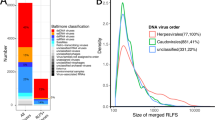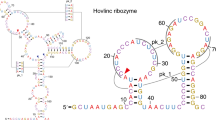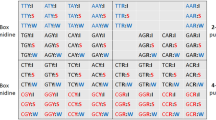Abstract
Several recent discoveries1 have pointed to nucleic acid secondary structure as an additional dimension in gene expression2. Further evidence for the formation of hairpins in RNA is the fact that cruciforms exist in negatively supercoiled DNAs3–5. As potential binding sites for proteins, these structures have been proposed to play a part in the regulation of various crucial reactions, such as replication6,7, transcription8, or RNA processing9. As any random nucleotide sequence can self-anneal with an approximately 50% chance of forming some Watson-Crick-type base pairs10, it is difficult to assess which, if any, of all possible hairpin-like secondary structures may be biologically relevant. We have computed the expected distribution of perfectly base-paired structures as a function of loop size and stem length and compared it with the distribution observed in the complete genome of eight DNA viruses from animals, plants and bacteria. We report here that hairpins having six or more consecutive base pairs in the stem are not distributed randomly along the genome, occur much more often than chance would predict, and are particularly over-represented in regions that appear to have regulatory significance. The average loop size was found to decrease with an increase in stem length. These results support our previous hypothesis that these structures are biologically relevant11.
This is a preview of subscription content, access via your institution
Access options
Subscribe to this journal
Receive 51 print issues and online access
$199.00 per year
only $3.90 per issue
Buy this article
- Purchase on Springer Link
- Instant access to full article PDF
Prices may be subject to local taxes which are calculated during checkout
Similar content being viewed by others
References
Cantor, C. R. Cell 25, 293–295 (1981).
Wells, R. D. et al. Prog. Nucleic Acid Res. molec. Biol. 24, 167–267 (1980).
Panayotatos, N. & Wells, R. D. Nature 289, 466–470 (1981).
Hassanoot, C. A. G. et al. Nucleic Acids Res. 8, 169–181 (1980).
Lilley, D. M. J. Nucleic Acids Res. 9, 1271–1289 (1981).
Sims, J. et al. J. biol. Chem. 254, 12615–12628 (1979).
Suggs, S. V. & Ray, D. S. Cold Spring Harb. Symp. quant. Biol. 43, 379–388 (1978).
Rosenberg, M. et al. Nature 272, 414–423 (1978).
Guaneros, G. et al. 7th Int. Biophys. Congr. 3rd Pan-Am. Biochem. Congr., Mexico City (Abstr. TH-0-42, 1981).
Fitch, W. M. J. molec. Evolut. 3, 279–291 (1974).
Müller, U. R. & Fitch, W. M. in Bacteriophage Assembly (ed. DuBow, M. S.) 285–297 (Liss, New York, 1981).
Sanger, F. et al. J. molec. Biol. 125, 225–246 (1978).
Godson, G. N. et al. Nature 276, 236–247 (1978).
Beck, E. et al. Nucleic Acids Res. 5, 4495–4503 (1978).
Reddy, V. B. et al. Science 200, 494–502 (1978).
Deininger, P. L. et al. Nucleic Acids Res. 8, 855–860 (1980).
Meyer, T. F. & Geider, K. J. biol Chem. 254, 12642–12646 (1979).
Weisbeek, P. et al. Eur. J. Biochem. 114, 501–507 (1981).
Schaller, H. et al. in The Single-Stranded DNA Phages (eds Denhardt, D. T., Dressier, D. & Ray, D. S.) 139–163 (Cold Spring Harbor Laboratory, New York, 1978).
Galibert, F. et al. Nature 281, 646–650 (1979).
Franck, A. et al. Cell 21, 285–294 (1980).
Charnay, P. et al. Nucleic Acids Res. 7, 335–346 (1979).
Pasek, M. et al. Nature 282, 575–579 (1979).
Covey, S. N. & Hull, R. Virology 111, 463–474 (1981).
Simons, G. F. M. et al. in Bacteriophage Assembly (ed. DuBow, M. S.) 401–411 (Liss, New York, 1981).
Sutcliffe, J. G. Cold Spring Harb. Symp. quant. Biol. 43, 77–90 (1978).
Tinoco, J. et al. Nature new Biol. 246, 40–41 (1973).
Van Heuverswyn, H. & Fiers, W. Eur. J. Biochem. 100, 51–60 (1979).
Author information
Authors and Affiliations
Rights and permissions
About this article
Cite this article
Müller, U., Fitch, W. Evolutionary selection for perfect hairpin structures in viral DNAs. Nature 298, 582–585 (1982). https://doi.org/10.1038/298582a0
Received:
Accepted:
Issue Date:
DOI: https://doi.org/10.1038/298582a0
This article is cited by
-
Asymptotic Number of Hairpins of Saturated RNA Secondary Structures
Bulletin of Mathematical Biology (2013)
-
Nucleosome “phasing” and cruciform structures in circular supercoiled pBR322 DNA
Cell Biophysics (1984)
Comments
By submitting a comment you agree to abide by our Terms and Community Guidelines. If you find something abusive or that does not comply with our terms or guidelines please flag it as inappropriate.



